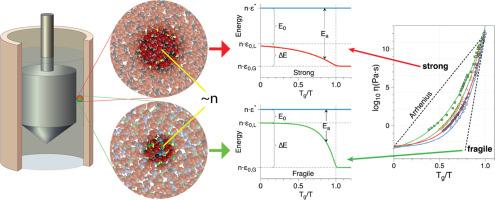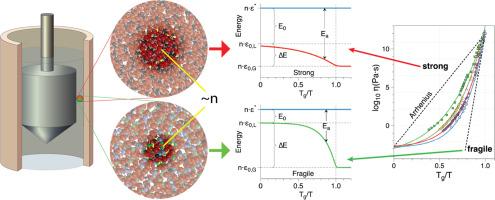Correlative activation free energy (CAFE) model: Application to viscous processes in inorganic oxide glass-formers
IF 8.3
1区 材料科学
Q1 MATERIALS SCIENCE, MULTIDISCIPLINARY
引用次数: 0
Abstract
We explore the concept of correlative activation free energy (CAFE) for the analysis and interpretation of viscosity data of a collection of 847 inorganic oxide glass formers that exhibit various degrees of non-Arrhenius behavior. The CAFE model formalism is strictly based on transition state theory and accounts for the variation in the activation barrier height for the viscous dissipation due to the structural evolution the system undergoes upon traversing the glass transition regime. Thus, fitting parameters are meaningful in a statistical thermodynamic context. Compared to the VFT and MYEGA equations, fits using the CAFE model are more robust when extrapolating to infinite temperature because the latter encodes non-enthalpic contributions to the rate coefficient more realistically. The CAFE model-based analysis reveals a strong connection between melt fragility and the degree of change in the potential energy landscape with temperature. Accordingly, while the average ground-state potential energy of the glass forming liquid gradually increases with temperature, the energy of the activated state remains relatively invariant. Our analysis also allows one to estimate the number of atoms involved in the viscous relaxation process, which ranges from approximately 10 to 50 atoms for the oxide glass formers studied. We observe that thermally activated dynamic phenomena exhibited by glassy networks, such as the mixed alkali effect, persist into the supercooled liquid state.


相关活化自由能 (CAFE) 模型:应用于无机氧化物玻璃成型器中的粘性过程
我们探索了相关活化自由能(CAFE)的概念,用于分析和解释 847 种无机氧化物玻璃成型器的粘度数据,这些玻璃成型器表现出不同程度的非阿伦尼斯行为。CAFE 模型形式严格基于转变态理论,并考虑了由于系统在穿越玻璃转变体系时经历的结构演变而导致的粘性耗散活化势垒的变化。因此,拟合参数在统计热力学背景下是有意义的。与 VFT 和 MYEGA 方程相比,使用 CAFE 模型进行拟合在外推作用到无限温度时更为稳健,因为后者更真实地编码了非enthalpic 对速率系数的贡献。基于 CAFE 模型的分析表明,熔体脆性与势能景观随温度变化的程度密切相关。因此,虽然玻璃形成液的平均基态势能随着温度的升高而逐渐增加,但活化态的能量却保持相对不变。通过我们的分析,还可以估算出参与粘性弛豫过程的原子数量,在所研究的氧化物玻璃形成液中,原子数量大约在 10 到 50 个之间。我们观察到,玻璃态网络表现出的热激活动态现象(如混合碱效应)会持续到过冷液态。
本文章由计算机程序翻译,如有差异,请以英文原文为准。
求助全文
约1分钟内获得全文
求助全文
来源期刊

Acta Materialia
工程技术-材料科学:综合
CiteScore
16.10
自引率
8.50%
发文量
801
审稿时长
53 days
期刊介绍:
Acta Materialia serves as a platform for publishing full-length, original papers and commissioned overviews that contribute to a profound understanding of the correlation between the processing, structure, and properties of inorganic materials. The journal seeks papers with high impact potential or those that significantly propel the field forward. The scope includes the atomic and molecular arrangements, chemical and electronic structures, and microstructure of materials, focusing on their mechanical or functional behavior across all length scales, including nanostructures.
 求助内容:
求助内容: 应助结果提醒方式:
应助结果提醒方式:


